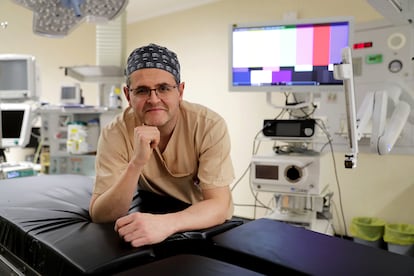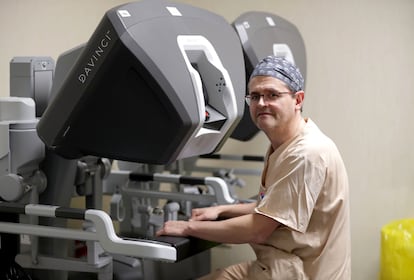Roberto Ballestero Diego, urologist: ‘In the next decade there will be surgical robots for every specialty and pathology’
The specialist has been performing robot-assisted operations since 2010, consolidating himself as one of the top experts in the field in Spain

With more than two decades of experience, Roberto Ballestero Diego, 47, head of the urology section at the Marqués de Valdecilla University Hospital in Santander, Spain, has witnessed the remarkable evolution of his field, which has gone from open surgery to endoluminal surgery (performed through physiological conduits), conventional laparoscopy (which introduces the surgical tools through minimal incisions in the skin) and robot-assisted surgery. Since the arrival in Spain in 2005 of the first surgical robot Da Vinci, made by the American company Intuitive Surgical, its applications have extended to areas such as general and thoracic surgery (for example, to guide lung biopsies), ear, nose, and throat (ENT) operations, gynecology and orthopedic surgery, and to implant knee prostheses. More advanced models have also emerged and new European and Asian competitors are revolutionizing the sector.
This specialist has been operating with surgical robots since 2010, consolidating himself as one of the top experts in the field in Spain. He trains urologists from other centers and coordinates the endourology, laparoscopy and robotics group of the Spanish Urology Association (AEU), which brought together almost 500 specialists in Bilbao on January 30 and 31 to share experiences and discuss scientific advances on topics such as urological cancer and benign prostatic hyperplasia (BPH), which is very common in men over 80 years of age.
Question. What new techniques exist to treat BPH?
Answer. In the last 20 years, techniques have emerged that compete with transurethral resection of the prostate, which was the first endourological advance over open surgery. This pathology affects the quality of life with symptoms such as weak urinary stream and incontinence, but each patient is unique and it is crucial to personalize the treatment. These alternatives include laser enucleation of the prostate, which promises to become the main one because it has fewer complications, such as urinary incontinence. Another innovation is water vapor ablation, which, with robotic assistance, breaks down the prostate in just 10 minutes, although it faces challenges related to bleeding.
Q. Have there also been advances for prostate cancer?
A. The most common robotic surgery worldwide is for prostate cancer. In such small areas, it offers greater precision in preserving the nerves responsible for erection and the urinary sphincter, reducing the risk of erectile dysfunction and incontinence. Similarly, radiotherapy for this type of cancer has advanced towards more precise techniques. Robotic surgery has also proven useful in pathologies specific to women, such as in the treatment of pelvic prolapse, where it is progressively replacing open and laparoscopic techniques.
Q. How does a surgical robot work?
A. It is a multiport robot with four arms controlled from a console, one for the camera and three for the instruments. It is not autonomous, it operates under a master-slave model assisting the surgeon. It is ideal for large spaces such as the abdomen and pathologies of the kidney, adrenal and ureters, as well as for pelvic surgery in prostate and bladder cancer, standing out in urinary reconstruction. With its 3D vision, the elimination of tremor and its greater precision, it has democratized laparoscopic surgery, making it accessible to more surgeons. There are already groups that are beginning to perform kidney transplants with robotic surgery.

Q. What other innovations are expected?
A. The single-port robot, approved in Europe in 2024, which allows the introduction of those four robotic arms through a single orifice, will be key in surgeries in smaller spaces, such as maxillofacial, ENT or pediatric surgeries. Robotic surgery is experiencing a boom that for years has been limited by price, but in the next decade an expansion is expected with specific robots for each specialty and pathology.
Q. How will competition from new companies impact you?
A. The Da Vinci robot first emerged as a NASA and U.S. Army project for remote surgery and military applications, which has since evolved commercially. Until three or four years ago the company that had the hegemony and the patents was the American company Intuitive Surgical, which also bought up any other company that competed with it, but now new robots are emerging in the U.S., Europe and Japan, such as Hugo (Medtronic), Versius (CMR Surgical) and Hinotori (Medicaroid). There are also some in Korea, although this country has a very lax patent law that facilitates copying, which limits its ability to export to the U.S. or Europe.
But in recent years, many of the patents for the multiport robot have expired, so many companies, mainly Chinese ones, are starting to offer their surgical robots. I think that only one has the CE mark [that allows sales in the EU], but it is foreseeable that in the next few years there will be different Asian companies that will introduce their robots here, or rather copies of the old ones from Intuitive, which can change the global scenario of robotics, making it much more accessible to many more hospitals.
Q. Will robotic surgery evolve into autonomous systems?
A. In the short term, robotic surgery will not be autonomous, but it will improve with advances such as tactile sensitivity. Competition will also reduce costs because for the last two decades robots have been a luxury product: right now, they cost €2 million and maintenance costs another €250,000 a year, plus the consumables for each operation, which ranges from €1,500 to €3,500. That is why, in Spain, they were initially only available in some regions and, although most have them today, they are still not accessible to many regional hospitals.
Q. Are there applications in telesurgery?
A. In 2001, surgery was carried out on pigs between New York and Strasbourg. Today, there are projects by European and American medical societies with some experiments carried out, including on people, and a clear application in teaching. Although it could also be useful in developing countries, this remains a distant concept due to the costs and the infrastructure required.
Q. What role could artificial intelligence play?
A. It could assist in real-time surgical navigation [helping to locate structures or lesions], which in abdominal surgery faces challenges due to the movement of organs and blood vessels. With more sophisticated AI models, in the coming years we will see systems capable of compensating for these movements and offering more precise surgical assistance. All of this promises increasingly important changes in the future.
Sign up for our weekly newsletter to get more English-language news coverage from EL PAÍS USA Edition
Tu suscripción se está usando en otro dispositivo
¿Quieres añadir otro usuario a tu suscripción?
Si continúas leyendo en este dispositivo, no se podrá leer en el otro.
FlechaTu suscripción se está usando en otro dispositivo y solo puedes acceder a EL PAÍS desde un dispositivo a la vez.
Si quieres compartir tu cuenta, cambia tu suscripción a la modalidad Premium, así podrás añadir otro usuario. Cada uno accederá con su propia cuenta de email, lo que os permitirá personalizar vuestra experiencia en EL PAÍS.
¿Tienes una suscripción de empresa? Accede aquí para contratar más cuentas.
En el caso de no saber quién está usando tu cuenta, te recomendamos cambiar tu contraseña aquí.
Si decides continuar compartiendo tu cuenta, este mensaje se mostrará en tu dispositivo y en el de la otra persona que está usando tu cuenta de forma indefinida, afectando a tu experiencia de lectura. Puedes consultar aquí los términos y condiciones de la suscripción digital.
More information
Archived In
Últimas noticias
James Cameron: ‘For the films I like to make to continue to exist, we have to find a way to make them cheaper’
Families demand repatriation of bodies of Colombians who died in Ukraine: ‘This war is a slaughterhouse for foreigners’
Mexico’s missing people crisis casts a shadow over World Cup venue
ICE raids trigger school absenteeism and traumatize children: ‘They have been forced to leave their childhood behind’
Most viewed
- Christian Louboutin: ‘Young people don’t want to be like their parents. And if their parents wear sneakers, they’re going to look for something else’
- US sanctions against jailed cartel leader ‘El Marro’ highlight Mexico’s lack of control over its prisons
- Cartels in Mexico take a leap forward with narco-drones: ‘It is criminal groups that are leading the innovation race’
- Liset Menéndez de la Prida, neuroscientist: ‘It’s not normal to constantly seek pleasure; it’s important to be bored, to be calm’
- ‘El Limones’ and the growing union disguise of Mexican organized crime











































